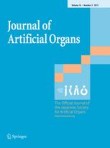
Abstract
Background
Redictors of repetitive left-ventricular assist device (LVAD)-thrombosis have not been studied yet.
Methods
We identified predictors of recurrent LVAD thrombosis in HeartWare (HVAD) patients in a long-term study from 2010 until 2020. We included all patients with two or more thrombolysis treatments for repetitive HVAD thrombosis and effectiveness of thrombolytic therapy was defined as freedom from stroke, death, another HVAD thrombosis, or surgical device exchange within 30 days after the event. Study endpoints also include all-cause mortality and heart transplantation.
Results
A total of 534 HVAD implantations have been screened, and 73 patients (13.7%) developed first HVAD thrombosis after a median of 10 months (IQR; 6–21 months). 46 of these patients had effective thrombolysis in 71.7% (n = 33/46). After a median of 14 months (IQR 4–32 months) follow-up, 17 patients (51.5%) had developed a second HVAD thrombosis and all were treated with t-PA therapy again, resulting in effectiveness in 76.5% (n = 13/17). The four patients with ineffective t-PA therapy underwent subsequent surgical HVAD exchange. Multiple Cox regression model analysis revealed time interval between HVAD implantation and first thrombosis as an independent risk factor of recurrent thrombosis (HR, 0.93, 95% CI 0.87–0.99, p = 0.031). Kaplan–Meier analysis at 3 year follow-up showed no significant difference in overall survival for recurrent vs non-recurrent thrombosis groups (log-rank test, p� �= 0.959).
Conclusion
Recurrent HVAD thrombosis mostly appears within 12 months after first thrombosis. Systemic t-PA therapy for recurrent pump thrombosis seems safe, achieving comparable effectiveness rates to initial t-PA therapy. Survival does not differ between patients with or without recurrent HVAD thrombosis.



No comments:
Post a Comment